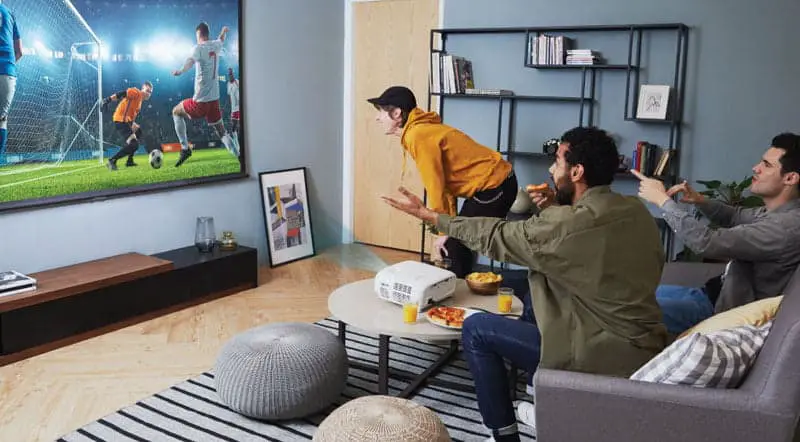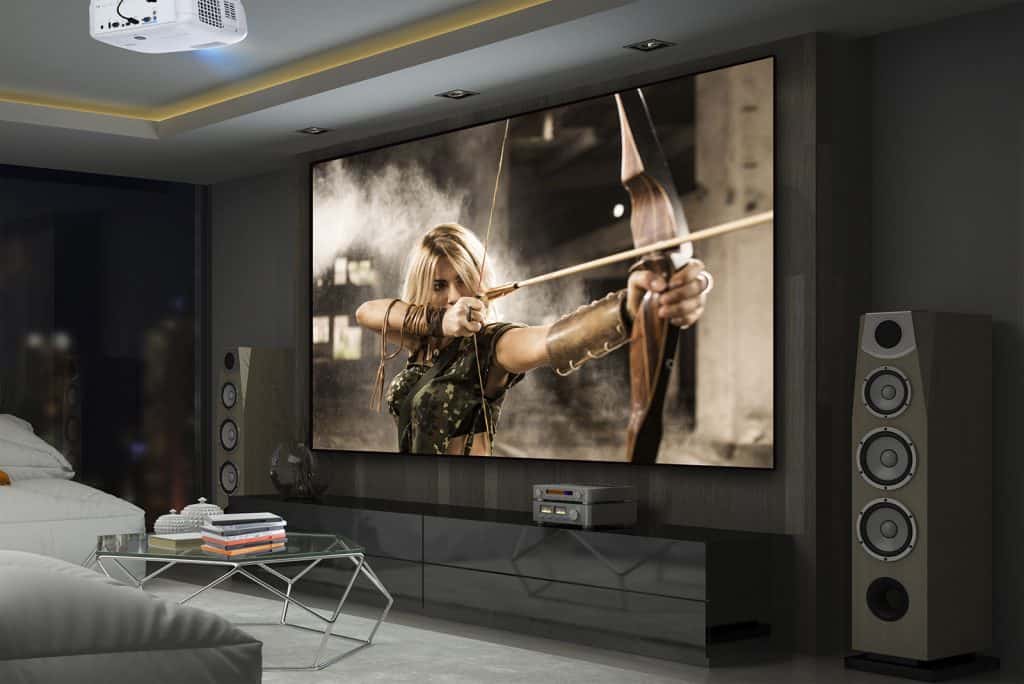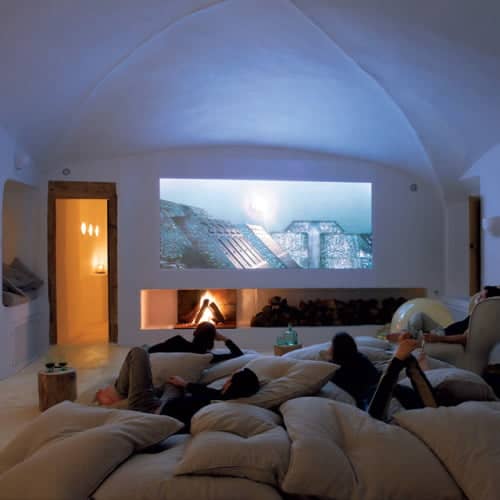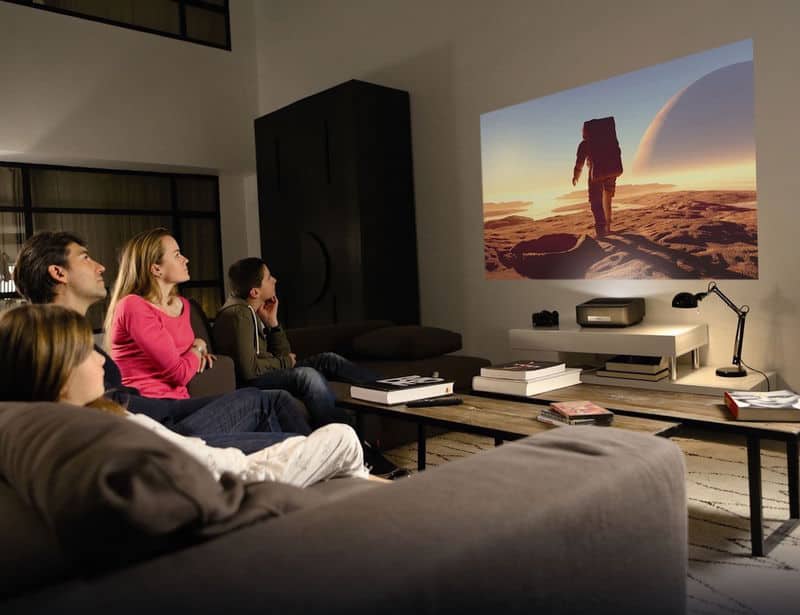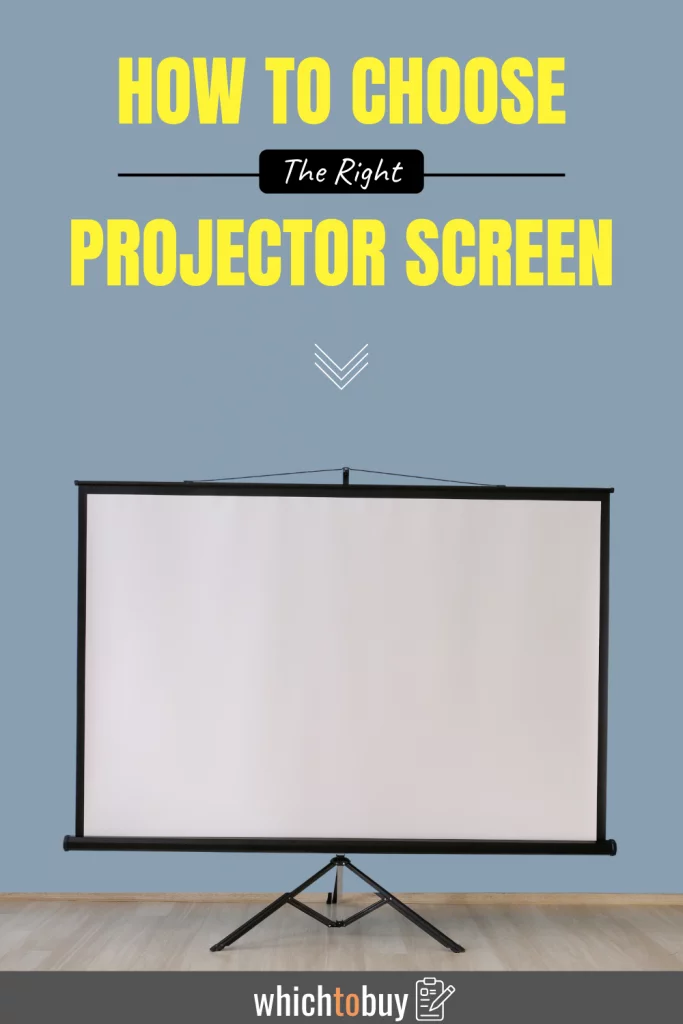You’ve decided to buy a projector for your home theater, but you’re constantly asking yourself “Do I need a projector screen?” After all, projecting a movie or a video game onto a wall could work out as well and help you save some money. Well, we’re here to help you decide and show you all the pros and cons of buying a projector screen!
The thing is, many people believe that a white wall or a white bed sheet is as good as a projector screen. But, there is a reason why projector screens exist and that is the quality of the image. Projecting onto a wall will heavily compromise image color, contrast, and detail.
Why does this happen? Well, simply because the conventional paint that you use to paint your wall isn’t designed to reflect light evenly and, no matter how smooth the plaster on the surface is, the light will be scattered. A sheet is just as bad, or even worse since it lacks the flatness of a wall. Long story short, if you want the best cinema experience, you will need a projector screen. But, unfortunately, a projector screen comes with some disadvantages as well (besides the additional cost).
Keep reading to find out the advantages and disadvantages of using a projector screen and decide whether it is the right option for you!
Table of Contents
Advantages & Disadvantages of Projecting onto a Projector Screen
Image Courtesy of View Sonic
The very moment you start thinking of buying a projector screen, you will find yourself thinking “Do I need a projector screen at all?” The reason behind this is probably the additional cost. But, the good news is that the projector screens don’t have to be too expensive. You can find a decent model from below £100. Even though this is not an insignificant sum of money, you probably knew that building a home theater would cost you, so adding £100 to the total isn’t too much.
The biggest advantage of getting a projector screen is greater control than you’d get with a bare wall. A perfectly smooth wall is a good option, but even the minor imperfections could affect your projected image. A projector screen also gives you more control over how much light gets reflected: a screen with a matte coating will have a much easier time of keeping ambient light from ruining your image.
Then, you have to think of the wall color. If you own your apartment or home, this won’t be an issue. But, if you’re renting a place then you might be stuck with a wall color that can make the projected image look too bright or too dark.
The downside of getting a projector screen is that it is permanent. Once you place it on your wall, there will be no more moving around. If you’re projecting on a wall, you can change the position of your projector to make the image larger. However, if you have a screen, then you’d have to replace it with a larger model. That would be a completely unnecessary expense.
Advantages & Disadvantages of Projecting Onto a Wall
Image Courtesy of C. Walker
Well, let’s start this point with money as well. Obviously, the biggest advantage of projecting on a wall is that you don’t have to spend money on a screen. Even though we mentioned that projector screens don’t have to be pricey, you’ll probably want to go for a more expensive budget to make sure you get the best image quality possible. And, this might cost you a few hundred pounds.
Another advantage of projecting onto a wall is that you can move your projector around. Place it wherever you want, make some minor adjustments, and there you go! You probably won’t move your projector around too much, but it’s nice to know that you have some flexibility. Also, if you decide to move, you won’t have to deal with the tedious task of taking down and remounting your projector screen (which can get damaged during the move).
Also, a lot of projectors come with a setting to correct for the color of your wall. This feature varies from model to model, but it can be quite useful since the projected image will be high in quality, even though you don’t have the screen.
Do I Need a Projector Screen or Will a Bare Wall Be Enough?
Image Courtesy of PC Fans World
Whether you buy a projector screen depends on your current situation. If you’re sure that you won’t move the projector and the furniture around as long as you live in your home, then there is no reason why you should get a projector screen. Except for the money…
Getting an affordable projector screen is always an option. Some manufacturers, such as Nierbo, offer a 100-inch screen for about £25, whereas their 300-inch screens cost around £150. The reason for these prices is that the screens don’t have a sturdy metal frame that will protect them.
If you’re still having doubts, then we recommend projecting the image onto a wall for starters. There won’t be any harm done and you can test how well does your projector perform if you’re not ready to fork out the money for a screen immediately. Once you start watching a movie or playing a video game, you will fall in love with the new experience and you’ll forget about all the imperfections that we mentioned.
Keep in mind that your wall should be painted in matte white or light gray paint to get the best possible image quality. You may also come across “projector screen paint” for your walls, but, don’t let these products fool you. They may be slightly better than regular paint, but they are way too expensive. Some brands are expensive to the amount that you can buy a projector screen instead of the paint then.
Haven’t made up your mind yet? Well, if you’re still thinking “Do I need a projector screen,” here are a few tips you should keep in mind if you decide to get one.
How To Choose The Right Projector Screen
1. The Position
Before you even start looking for a projector screen, you should have an idea of where it’ll go. You’ll need to find a large enough well and make sure that the furniture can be placed near it so that everyone sees the screen well.
In addition, you also have to make sure that there is easy access to a power outlet.
2. The Size
If you decide to treat yourself with a projector screen, you might be tempted to get the largest one that can fit in the available space in your room. Typical sizes range from 96 to 120 inches, and you should make sure that it’s possible to see the bottom edge of the screen from every seating position.
To be 100% sure if your projector will fill the screen from its position, you can calculate the image width. To do this, find the throw ratio of your projector and divide the distance between the projector and the screen. The result will be the image width.
How does the formula work? Well, if you have a screen that is 2.6m wide and a projector that features a throw ratio of 1.3, you’ll need to put the projector 3.38m away from the screen.
3. Type of the Screen
There are two different types of projector screens. You can either go for a fixed model that has to be mounted on a wall or a roll-up option that can be stored after use. The type of model you should buy depends on whether the room you plan to put it in is a multi-use space. If it is, then putting the screen away after use makes much more sense.
If you have an extra room you plan to turn into a home theater, then the fixed option is the way to go. These screens are always ready for viewing and adequately tensioned to ensure a smooth, flat surface for the projector’s image.
Even though most projector screens come in white, you can also find grey or black variants. These darker options should be used in brightly-lit rooms.
4. The Frame
When buying a TV, people usually go for models that have a minimal border. However, you shouldn’t follow this trend when choosing a projector screen. The rule of thumb for these screens is the wider the frame the better the image quality.
The frame should be covered with black light-absorbing material so that any part of the projector image that falls on it isn’t reflected. This means that you won’t have to perfectly align the projector’s image.
5. The Screen Gain
If you look at the specifications of any projector screen, you will notice a gain figure. A gain of 1.0 means that the screen reflects all the light that shines on it. Higher numbers mean that the image on the screen will be brighter when looked at from straight ahead, but the quality will suffer when viewed from wider angles.
You should choose a higher gain screen if you plan to place it in a bright room. If you bought a projector that doesn’t render blacks well or you placed it in a darker room, it’s worth considering a screen with a gain below 1.0. This will help make things darker and optimize image quality. If your projector has enough light output, the loss of reflected light should not be an issue, so the gains will be worth it.
Still don’t have a projector? Check out our list of high-quality, yet affordable projectors that will help you turn your ordinary room into a cinema!
Hopefully, you’re not asking yourself “Do I need a projector screen” anymore. Let us know in the comments below which option you decided to go for! Will a projector screen work better for you or does your projector work well on a bare wall?

